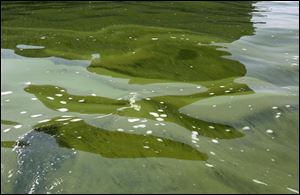
Injecting fertilizer might save lake
Farm nutrients considered key in algae
12/3/2016PORT CLINTON — Western Lake Erie basin agriculture can achieve most of the 40 percent reduction goal set for algae-forming nutrients by doing one thing: Convincing more farmers to inject their fertilizers below ground rather than continuing to spread them on the surface.

Algae is visible in Lake Erie near the Toledo water intake crib in this file photo.
According to an ongoing research project that involves about 15 Great Lakes scientists and headed by the University of Michigan, cereal rye cover crops and buffer strips also are among the most effective practices at controlling runoff.
Details were presented to about 100 people at an annual forum at Catawba Island Club sponsored by the newly formed Lake Erie Foundation.
The foundation is a collaboration between two advocacy groups, the Lake Erie Improvement Association and Lake Erie Waterkeeper. It was set up to encourage more long-term business investment in the lake.
Ohio, Michigan, and Ontario agreed in 2015 that a 40 percent reduction in nutrient loading from 2008 levels is necessary to make meaningful progress in the war against toxic microcystis algae — which is on the rise globally but getting high-profile attention in the western Lake Erie basin because of the 2014 algae crisis that led Toledo to declare its tap water unsafe for three days.
Jeff Reutter, Ohio Sea Grant and Ohio State University special adviser, updated the audience on efforts the U.S. and Canadian governments are likewise taking to promote that goal under the latest version of the Great Lakes Water Quality Agreement the two nations signed in 2012 through the International Joint Commission.
The research on most effective farming practices was presented by Margaret Kalcic, an assistant professor of OSU’s food, agricultural, and biological engineering department, who said she was a postdoctoral student under U-M researcher Don Scavia when he began leading the project.
Using a variety of models, the research team identified direct injection as the most-effective method to control runoff and one that would not reduce crop yields.
The problem is it’s not widely embraced and needs to be done by at least half of the Maumee River watershed’s farmers to make a large impact, Ms. Kalcic said.
“We had hoped that 10 percent on targeted land would do a lot, but found it didn’t,” she said. “We really have to be looking at actions on farmland.”
The research disputes the notion that a 40 percent reduction is impractical, Ms. Kalcic said.
“We do see there are pathways to that 40 percent and we were able to maintain yields [in their modeling],” she said. “If we can get the phosphorus into the soil, that does an awful lot.”
Agriculture leaders have acknowledged in recent years that farm runoff is responsible for most of the nutrients.
Mr. Reutter said the contribution from sewage spills is now estimated between 3 and 8 percent of the total.
Scientists say the biggest problem isn’t combined sewer overflows, because the algae problem has been getting worse throughout the past 20 years while cities such as Toledo have spent millions of dollars expanding and modernizing their systems to reduce spills, Mr. Reutter said.
Both the Maumee and the Detroit Rivers put about 2,500 tons of phosphorus a year into western Lake Erie. The Maumee’s flow is much more concentrated. Toledo’s annual contribution is about 150 tons, whereas the much larger Detroit wastewater treatment plant typically releases 200 to 700 tons a year, Mr. Reutter said.
Contact Tom Henry at: thenry@theblade.com, 419-724-6079, or via Twitter @ecowriterohio.